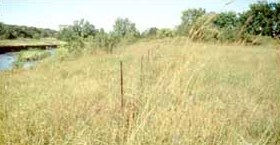Indian Village State Preserve facts for kids
|
Indian Village Site (Witrock Area)
|
|
 |
|
| Location | Left bank of Waterman Creek, east of Sutherland |
|---|---|
| Nearest city | Sutherland, Iowa |
| NRHP reference No. | 66000888 |
Quick facts for kids Significant dates |
|
| Added to NRHP | October 15, 1966 |
| Designated NHL | July 19, 1964 |
The Indian Village State Preserve, also known as the Wittrock Indian Village State Preserve, is a special place in Iowa. It is an archaeological preserve near Sutherland, Iowa. This 6-acre area protects the Indian Village Site (13OB4), which was once a fortified village. It belonged to the ancient Mill Creek culture.
This important site was named a National Historic Landmark in 1964. Later, in 1968, it became a state preserve. You can find it east of Sutherland, south of 455th Street and west of Yellow Avenue. To visit the preserve, you need to cross private land.
The Wittrock Indian Village
The Wittrock Indian Village is located on a flat area of land called a terrace. This terrace overlooks Waterman Creek. People lived here for about 300 years, around the year 1200 CE. This means the village was active about 800 years ago!
What Was This Village Like?
The entire village was surrounded by a strong wooden fence, called a stockade. This stockade was likely built to protect the villagers from other Native American groups. Inside the stockade, there were about 20 lodges. These lodges were homes that were partly built underground. Each lodge was about 20 by 30 feet in size. To get inside, people used entry tunnels. Every lodge also had its own fireplace for warmth and cooking, and a storage pit to keep food and other items safe.
Discovering the Past: Archaeology
The state of Iowa bought this site in 1937. Since then, many professional archaeologists have studied it. They dig carefully to find clues about the past. The first major dig by the state happened in 1965. During this excavation, archaeologists learned a lot about the stockade and how the homes were built.
The site is near a creek, so it can be damaged by water wearing away the land. This is called erosion. To help protect the site, the state has put in special wire cages filled with rocks, called gabions, along the creek bank. These gabions help stop the erosion.
The items found at the site, like tools and pottery, are kept safe. Some are at the University of Wisconsin in Madison, and others are at the state archaeological office. To help visitors imagine what the village looked like, the state has even rebuilt a part of the stockade. This gives a good idea of what life might have been like in the village long ago.



